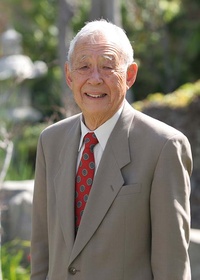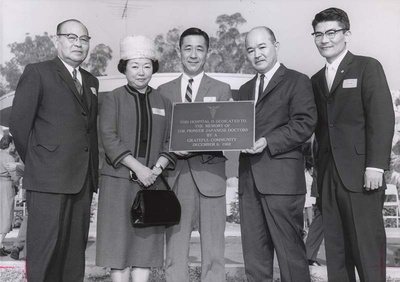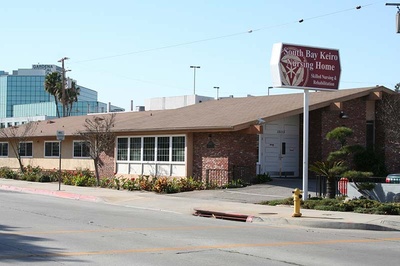Although a number of Nikkei and Asian eldercare organizations grew organically out of existing Japanese Issei “Pioneer” or community centers, church, or civic organizations, Keiro Senior HealthCare was different; it rose out of the vision and energy of a close-knit group of Nisei professionals.
Keiro founder, chairman of the board for 14 years and current board member James Mitsumori, 88, recently talked about those early days from his law office at Third and San Pedro Streets in Little Tokyo.
Keiro’s founding members—George Aratani, Edwin Hiroto, Kiyoshi Maruyama, Gongoro Nakamura, Frank Omatsu, Joseph Shinoda, Fred Wada and Mitsumori—began their enterprise in 1961 with the purchase of the Japanese Hospital in Boyle Heights and its resurrection as City View Hospital in Lincoln Heights.
The Japanese Hospital itself was a major accomplishment for the Issei community of Los Angeles. Its history stretches back to 1924, when five Japanese doctors, represented by lawyer and champion of the Nikkei J. Marion Wright, fought for their right to incorporate and build the hospital. Their initial request for permission was turned down by Secretary of State Frank C. Jordan.
Wright, arguing that an existing U.S.-Japan commerce and navigation treaty granted Japanese aliens full protection of the law and therefore the right to incorporate and build the hospital, was victorious both at the California Superior and California Supreme Court levels. Both times, the state appealed the decisions. Finally, in 1928, the case went to Washington, D.C. and highest court in the land, where Wright prevailed. It was a huge victory for both Wright and the Japanese people. The Japanese hospital opened in 1929 at the corner of First and Ficket Streets.
The hospital, which opened in 1929, was run by and for Japanese immigrants during a period when they were not allowed to become U.S. citizens or to own land. It was a time when Japanese-born doctors were denied staff privileges at area hospitals, and Japanese American patients could not count on care from Caucasian-only hospitals. With no civil rights to protect them, the Japanese were left to their own means for the care of their sick and elderly.
The Japanese Hospital closed during World War II, when all people of Japanese descent living on the West Coast were evacuated and imprisoned. Fortunately, the hospital’s incorporation meant that it could not be seized; trustees were able to lease their building to White Memorial Hospital and reclaim and reopen it at war’s end.
By 1960, however, Mitsumori recalls, the hospital “was pretty antiquated. Its equipment was outdated, and it was not doing very well [financially]. Nisei doctors were no longer practicing there, and were sending their patients to other downtown hospitals.” Edwin Hiroto, who was the hospital’s administrator, learned that the 53-bed City View Hospital, a newer facility in Lincoln Heights, was available to lease or purchase, and hatched a plan to establish a new Japanese hospital on this site.
“I recall going over with Edwin to discuss this,” Mitsumori says. “City View was relatively new, and situated on top of a hill on Baldwin Avenue. The owner was having problems with the doctors or something like that, and had to close out the hospital. We negotiated a lease with an option to buy, and set a price.
“Kiyoshi Maruyama was a CPA, and he, Edwin and I were close friends and members of the Little Tokyo Optimist Club. I was an attorney, and Kiyo did some analysis. The trend in those days was for hospitals to go non-profit. That way they could receive donations and the hospital would be exempt from income tax,” recalls Mitsumori. The group formed a non-profit corporation, applied for tax exemption from the IRS, and formed its first board of directors.
The friends filled their board with prominent Little Tokyo Nisei: George Aratani was a businessman with close ties to Japan, Frank Omatsu was manager of the Little Tokyo Sumitomo Bank office, and Joseph Shinoda was the chairman of the Japanese Hospital. Hiroto was named CEO of the new City View Hospital. Doctors at the Japanese Hospital either sold or donated their stock in that for-profit corporation, providing some of the funding needed to take over City View.
The hospital was such a success, recalls Mitsumori, “it was getting boring.” The board asked City View doctors what they needed, and the resounding answer was a nursing home for its mostly Issei elderly patients. “George [Aratani] was going to Japan often on business, so he said, ‘I’ll see what kind of name would be appropriate.’” Aratani returned from Japan with advice from his contacts there, and suggested the name “Keiro,” which means “respect for elders” in Japanese. The group purchased and built the nursing home on a piece of property on Lincoln Park Boulevard, aided by an outpouring of donations from the community and loan guarantees by board members, some of them taking out mortgages on their own homes.
A purchase of five acres of land from the Jewish Home for the Aging in Boyle Heights made way for the Keiro Retirement Home in 1975, and the Keiro Intermediate Care Facility in 1977. Then a growing need for Nikkei eldercare in the Gardena and Torrance area led to a $1 million fund drive and the opening of South Bay Keiro Nursing Home in 1982.
The Whittier earthquake of 1987 caused extensive damage to the living quarters of the Retirement Home, although no one was hurt. The board estimated it needed $7 million to completely rebuild the retirement home, and another fund drive brought in $3.5 million from local supporters and a matching $3.5 million from Japan. Keiro also benefitted from an unexpected exchange rate windfall; by leaving the Japanese donations in a Tokyo bank while the initial stages of reconstruction began, recalls Mitsumori, the funds grew along with the worth of the yen, resulting in an increase in value from $3.5 to $4 million. When the board learned this, recalls Mitsumori, “We immediately had the money transferred to Los Angeles.”
Mitsumori’s own life is a window into the fortitude and resourcefulness of the Issei and Nisei generations. His Japanese-born father, Nisuke, volunteered and served in World War I, and was allowed to serve despite not being a citizen. He survived four major European battles, and, after the war, was awarded citizenship by special Congressional legislation. The GI bill enabled Nisuke to earn an accounting degree at Southwestern University and set up a practice in Little Tokyo. As one of the few Issei allowed to own property, he would buy land for his friends and transfer the deeds to their children once they reached the age of 21.
One of his father’s friends counseled the younger Mitsumori, an aspiring lawyer, to apply to the University of Michigan, home to one of the best law schools in the country. So it happened that when World War II broke out, he was a student in Michigan and was able to avoid being interned.
Nisuke, meanwhile, tried to volunteer once again for the army, but was turned down because of his age. Instead, he was tapped to become a Japanese language teacher for army officers at a new school at the University of Michigan. By the time his father arrived in Michigan in the fall of 1942 (and called for his wife and two daughters, who were interned at Gila River, Ariz.) the younger Mitsumori had already enlisted in the army himself. In 1944 he went on to fight in France and Italy with the illustrious 442nd Regimental Combat Team.”
After the war, Mitsumori re-enrolled in law school and completed his education. He also met and married his wife Nora, who had come from Hawaii to attend the University of Nebraska. Mitsumori notes, “During World War I, a lot of Germans lived in Nebraska. They were discriminated against too, and so were sympathetic to what the Japanese were going through during World War II. They set up a policy to permit 50 students from the camps to enroll at the university.”
When Keiro Retirement Home opened in 1989, Mitsumori moved his mother, Tane, 88, there. “She was living alone in Pasadena, and still driving,” Mitsumori recalls. “I told her, ‘The one thing you have to do is give up driving. You know Pasadena, but you don’t know Los Angeles.’” As one of the original founders of Keiro Senior HealthCare, Mitsumori says he is looking forward to the organization’s 50th anniversary in 2011. He still drives to work every morning from his home in Pasadena, arriving at his office at 8:45 a.m. and working until 2 or 2:30 p.m., Monday through Friday.
“I get good genes from my mother and father,” he says. “My father lived to 94, and practiced in Little Tokyo until he was 90. My mother lived to 98.”
© 2010 Nancy Matsumoto








